Board games, card games, tile laying games…I’ve played many over these past few years. I’m pleased to report that I’m adding miniature games to that list for the very first time. As a fan of the original X-Wing, TIE Fighter, and all other related video games in the series, what better way to introduce the kids and myself to the miniatures genre than taking a trip to a galaxy far, far away?
*Editor’s Note: A team variant is listed in the manual.
In Star Wars: X-Wing Miniatures Game, one player will assume the role of the Rebel Alliance while the other controls the Imperial Fleet. Both sides will have ships and bonuses that they can bring forth into their skirmish, each one having its own squad point value. Players agree on a set number of squad points to use and seed their fleets before the game begins, or they can choose to play one of the predefined scenarios.
The core game comes with an X-Wing and two TIE Fighters, along with some ship cards, upgrade cards, and everything else required to play. Expansion packs bring more ship types and abilities to the table, allowing players to customize their fleets in bigger and badder ways. Let’s take a quick look at the components and gameplay before heading into the review.
Components (Core Game)
Ships & Ship Tokens – One X-Wing and two TIE Fighter models make up the ships in this game. They attach via pegs to their bases. Each ship token lists one particular pilot and their unique stats. They are placed on the base of the ship model before the match starts to identify which pilot is flying what ship.
Tokens – There are plenty of other tokens available to help players keep track of their progress in the game. Action tokens are used when performing special abilities, mission tokens are used during certain scenarios, obstacle tokens can be added to the playing field to mess with player movement, shield tokens provide extra defense and keep track of a ship’s deflector shield strength, stress tokens are used during difficult maneuvers, critical hit tokens remind players on which ships suffered damage and penalties, and ID tokens are used for when multiple generic pilots are in battle.
Maneuver Templates & Dials – During one of the phases of a turn, players will use their dials to determine how a particular ship moves. Further along in the turn, the templates are used to physically move the ships from one end of the template to the other. There is a maneuver template for every movement action found on the dials, though not every dial has the same array of movement options…some ships are more nimble than others, for example.
Cards – There are a few different card types as well. Ship cards list a particular pilot’s abilities and what ship they fly, damage cards keep track of regular damage and critical hit damage, and upgrade cards represent special items that can be purchased and assigned to a ship before the match starts.
Dice – The red dice represent attack dice and the green dice represent defense dice. They are rolled during combat to resolve hits and determine damage, if any.
Range Ruler – The range ruler is used to determine if a ship is within firing range of another ship. It can also assist in determining a ship’s firing arc. Different bonuses and penalties apply, depending on how close or far away the other ship is in relation to the attacker.
Components (Expansions)
Below is a quick list of the expansions I purchased and what they came with.
X-Wing Expansion – This expansion comes with four pilots (including Wedge Antilles), one X-Wing model, a dial, and a set of cards and tokens.
TIE Fighter Expansion – This expansion comes with six pilots (including “Backstabber”), one TIE Fighter model, a dial, and a set of cards and tokens.
Y-Wing Expansion – This expansion comes with four pilots (including Horton Salm), one Y-Wing model, a dial, and a set of cards and tokens.
TIE Advanced Expansion – This expansion comes with four pilots (including Darth Vader), one TIE Advanced model, a dial, and a set of cards and tokens.
Setup & Gameplay
First, both players decide which faction they will be. Next, they gather their forces by agreeing on a squad point purchase limit…each ship card and upgrade card has a squad point value assigned to it, indicating its “strength.” The weaker cards cost less than the stronger ones, so players will decide how best to seed their forces before the game begins…players will get the most out of squad building when they include expansion packs. Once players lock in their forces, they assemble their ships and ship tokens appropriately. Players then place these ships in order of pilot skill (lowest going first) at a distance from their edge of the table no greater than “1” on the range ruler. The ship and upgrade cards being used are placed out of the way, but to where all players can see them. Shields token are placed on the appropriate ship cards and the damage card deck is shuffled. Any other components are placed out of the way, but within reach.
Alternately, players can choose to play from one of the three scenarios listed in the manual. Scenarios list special rules and instruct players on how to set everything up.
The game is played over a series of rounds until a victory condition is met, which vary from scenario to scenario. Those who don’t play using a scenario are simply tasked with destroying all of their opponent’s ships. The steps of a round can be summarized as follows:
1. Planning Phase – Each player chooses a maneuver for each of their ships by using the dial. The dials are placed face down near their respective ships as maneuvers are locked in.
2. Activation Phase – Players resolve their movement using maneuver templates, starting with the ship card of the lowest skill level. Each ship is allowed to perform an action afterwards, should they wish to, assuming that they don’t have a stress token on their ship. Red maneuvers add a stress token and green maneuvers remove a stress token.
3. Combat Phase – Players can attack one target within their firing arc and range, starting with the pilot with the highest skill level. Dice are rolled to determine hits, though a number of things (actions, range, etc.) can modify the number of dice rolled and the final outcome. A face down damage card is placed next to the ship card when they receive a regular hit, and a face up damage card is placed next to the ship card when they receive a critical hit. Face up damage cards affect the ship in various, negative ways. If a ship accumulates so many damage cards, it is destroyed and removed from the game.
4. End Phase – This is the clean-up phase in which players remove any appropriate tokens from the playing area and perform any end phase actions that may be listed on a card.
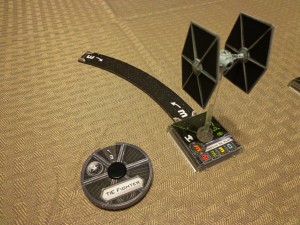
Movement is simply finding the template that you picked on your dial and moving your ship from one end to the other.
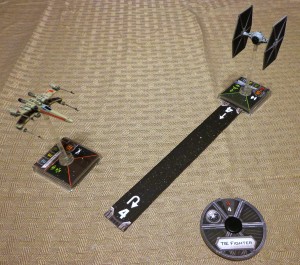
I suspected that my opponent would move toward me, so I played a high stress maneuver that flew me straight ahead and made me turn 180 degrees.
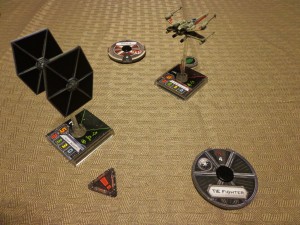
It worked…I had him right in my sights. I couldn’t use an action due to the high stress maneuver, but it allowed me to get a few shots off risk free.
The above is simply an overview of the game and I didn’t cover all of the gameplay mechanics, but it should still give you an idea of how it is played. For more information, you can check out the manual and video tutorial here:
Star Wars: X-Wing Miniatures Game Manual
Star Wars: X-Wing Miniatures Game Video Tutorial
The Review
First, I would like to commend Fantasy Flight Games for making such an excellent video tutorial. I showed it to my son Vinnie to give him an idea of what the game was like and he watched it without saying a word, as if he were entranced. Afterwards, he said excitedly, “Sure, I’ll play that with you!” The video doesn’t cover all of the content found in the manual, but sums up the game nicely. Well done!
While the video does a great job at giving an overview of gameplay, there’s still a bit of a learning curve when it comes to remembering what all of the abilities and actions do. New players may require a few playthrus to get a feel on how some of these abilities and actions work and when to use them. The manual is twenty-eight pages long, though to be fair, there are diagrams to help drive a few mechanics home and not all of it is gameplay related. Luckily, knowing all of the abilities and actions is not required to win…new players can explore as they go, mastering an ability here or learning about an action there. The kids and I actually did exactly that, and the first game was just as fun and engaging as the next.
I also appreciate how the ship classes and their specific characteristics were included in this game. I’ve played X-Wing, TIE Fighter, X-Wing vs TIE Fighter, X-Wing Alliance (all on the PC)…needless to say, I became familiar with how a lot of the ships in the Star Wars universe acted in combat. While the X-Wing is bulkier and slower to turn than a TIE Fighter, it has shields. Fans of the ships of the Star Wars universe will appreciate the detail and how they play in this game.
If I had one gripe, it would be the cost of the core game and the expansions. As of 9/19/12, the game was going for about $39.99 at Target, though I purchased it off of Amazon for about $33. Each expansion was about $15 and I purchased four of them through Amazon as well. As someone who loves larger space battles, I didn’t feel that one X-Wing and two TIE Fighter models were enough to warrant a $39.99 price tag for the core game. When you add it all up, you can be spending a little under a $100, which is quite the investment. Though, I admit, as a newcomer to the miniatures genre, this could be the standard. I also would have liked a way to store the expansions in the main box, similar to what Summoner Wars did with their insert. As it stands, my four expansions are in four separate baggies…not a big deal, but the plastic models are a bit fragile. I thought about removing the insert from the main box to fit everything, but the rectangular hole in the box lid would need sealed off in some manner to prevent the pieces from escaping. I would have been happier with a bigger box and thus more room to properly fit everything in one place.
Regarding the expansions, they were a lot of fun to play and my favorite thus far has to be the Y-Wing. It sports an ion cannon that can “disable” an enemy ship within a certain radius…that is…it flies straight ahead without the ability to much else. This can allow other ships approaching it to get some easy shots off while the Y-Wing flies away out of harms way. The TIE Advanced can be just as deadly, seeing as how it can sport shields, concussion missiles, and is a fairly nimble craft. It looks like there are more expansions in the works (as of 9/19/12) that includes the A-Wing, TIE Interceptor, Millennium Falcon, and Slave I…needless to say I’m excited. I wouldn’t mind a B-Wing, Z-95, TIE Defender, TIE Bomber…the list could go on.
Vinnie (11) and Anthony (16) both loved the game and the idea behind the miniatures. They were able to customize their forces how they wanted and enjoyed trying out different combinations. The challenge I had in my games with them was how I thought they might maneuver each turn so that I could play a maneuver that would put me into a favorable position once movement was resolved. At one point it turned into a never-ending loop of, “knowing that he knows that I know that he knows, he might go this way…however…”, but still, it was all in good fun.
Regardless of the cost, the Star Wars: X-Wing Miniatures Game and the four expansions I mentioned were fun to play and offers a lot in terms of replayability. The fact that there is no board allows players to use maneuvers to their fullest, opening up quite a bit of different strategies depending on the situation. Overall, I’m happy with the purchase as I intend to bring it out every chance I get and experiment with different ship /pilot / squad combinations. If you’re a fan of those old school video games that I mentioned earlier or just like a good dogfight, then you should seriously look into this game.
Final Verdict: 9/10
—
Interested in a space-themed play mat?
http://www.dadsgamingaddiction.com/star-wars-x-wing-miniatures-gameplay-mat/
Watch the entire series on YouTube here:
http://www.youtube.com/playlist?list=PLy-_-0rh3dPqL4QjProCuviOMKUVNKDkd
—

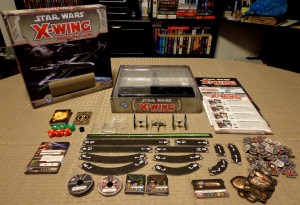
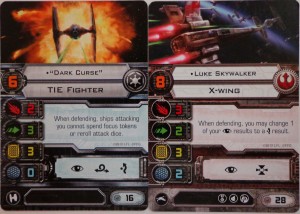

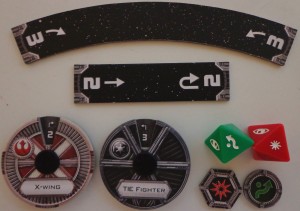
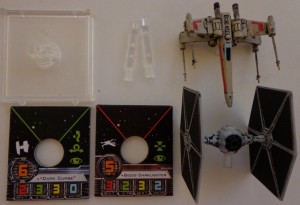
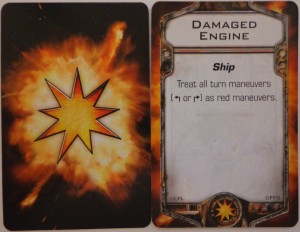
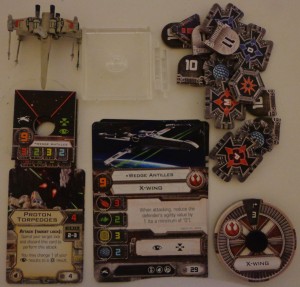
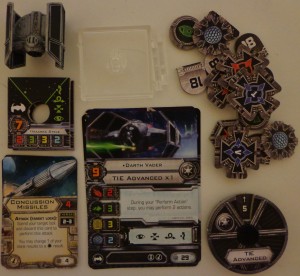
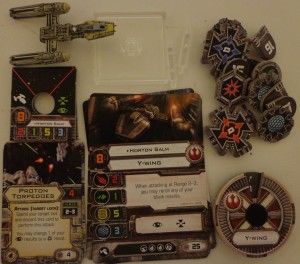
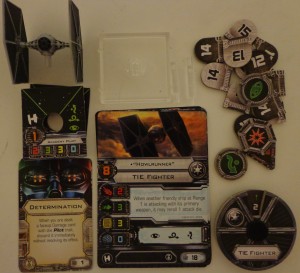
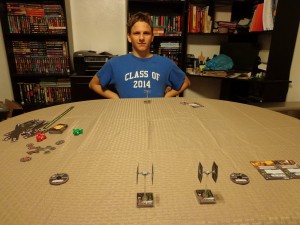
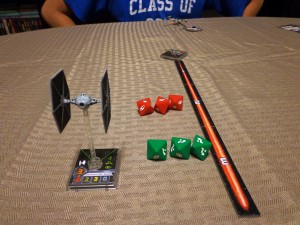
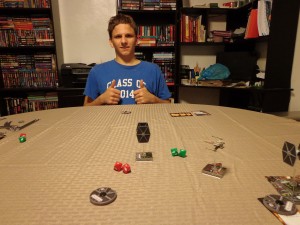
Since this is your first miniatures game, I think you may be looking at the cost from a board gamers point of view.
For a miniatures game this is probably less than average in price. The idea is that you don’t have to get everything (and even if you do it’s still cheaper than some miniatures games). You can decided on a squad you want and by the ships for that.
$60 for a standard sized squad compared to $300 for a standard sized army in some miniatures games talks for itself.
As for storage. If you just keep the plastic the expansions ships are in, not the outer plastic, you can use that outer plastic to cover up the hole in the lid of the core box, then get rid of the insert. All 4 of the expansions and the plastic storing the core ships will fit in the box with enough space for the bags of tokens and cards, etc.
Glad to hear you liked the game though. I’m still waiting for mine here in the UK, should arrive next week, just in time for my Birthday!
Good information! I had no idea that miniatures were so expensive.
Hi Keith – Just wanted to say if you are after expansions we have them in stock now. £10.49 and with free p&p. Base game is £26.99 free p&p.
http://www.fantasyboardgames.co.uk
Great blog. It just arrived in store today and will be playing it first chance we get.
Hi Dave, thanks for dropping by and for the compliment. I think you’ll enjoy the game, we certainly do!
It’s not a bad idea, if one is venturing into miniatures type games – or any games, really) to shop around a little more. I got my core sets for $25.97 ea (much better than MSRP $40 and almost 25% less than what you found on Amazon). The expansions were $9.72 ea.
Great review, thank you! Cost is always a factor in adopting a game. As JJ mentioned earlier, I shopped around and found good deals on the expansions, picking up the Y Wing, TIE Advanced and X Wing all together for US$20 total, through Amazon.
Being a miniature games guy (and hopelessly addicted to Battle Fleet Gothic) I was drawn to this space game seemingly for the wrong reasons, despite it being Star Wars, which is an A++++ situation for me. If they sold Star Wars feminine hygiene products I’d probably buy them, even though I’m a guy. yes, that’s sad. But it also illustrates a point. I didn’t buy this game right away, since as a miniature gamer, I hesitated. I shouldn’t have.
1. Pre-Painted models: I’m an OK miniature painter and have been so since 1986. That said, these pre-painted ships are AWESOME. While that doesn’t sell a game on its own, for a mini-gamer guy, it is incentive to get a game with no hobby-work required if painted quality is high, which it very much is. The visual appeal of the game on a table IS a big deal to all players, since it adds a visceral element that helps immerse you into the action. Coupled with the production quality of the tokens, cards and most importantly its game mechanic… it’s just very polished out of the box. I’ve played more expensive games with less “finish” than this. My opinion here is that this game is VERY well done for what it does. It seems to win over skeptical Star Wars fans AND skeptical miniature painters/gamers. That just isn’t easy to do. Yet, there is still room for casual players of all sorts. That’s a good deal for US$40.
2. Scale: This game is best described as a skirmish game. It obviously isn’t a fleet action, due to low number of ships. The scale of the dogfights is very personal and “tie”d into the above, lends itself well for players who want an hour game or more, since in most cases I’ve seen with this game, you are actively fighting and hanging out/talking/eating/drinking/whatever. It is a very pro-social game, despite trying to shoot your opponent out into hard vacuum.
While I don’t think this game has the legs that more expensive miniature games have in terms of support, room to grow, following or scalability, it also doesn’t need it. This is a dog fighting game between friends and outside of other expansions, it sits confidently in its niche with some room to grow.
Best,
Yeti